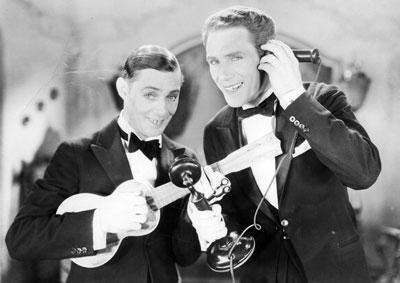“The dumb drama has found its tongue. The warmth of living voices has been brought to a silversheet long silent. Symphonies are being wafted from what has heretofore been a soundless screen. Trite as it may sound, it looks as if the cinema is entering a new sphere of usefulness.”—Herbert Moulton, “Silent Drama is Audible,” Los Angeles Times, September 12, 1926
Such went the typical praise surrounding the premier of Vitaphone technology, an early method of syncing recorded sound to film via 16” shellac discs. Film critics were astounded that vocal and musical reproductions could sound so “natural” or so “real.” Of course, the silent cinema was never truly silent, as at the very least live musical accompaniment was featured with every performance. However, the idea of synchronized sound, with both the image and the voice seemingly originating from the same human form, had long captured the imagination of movie audiences and producers alike.
Vitaphone technology developed from a collaboration between Warner Bros., Bell Laboratories and Western Electric. This was not the first time that synchronized sound technology had been attempted in film. However, Vitaphone technology had distinct advantages over early forms of sync sound. Namely, it was developed during a time when there were vast improvements in electronic amplification, which allowed the audio to be heard clearly throughout the theater in which it sounded. Furthermore, both the 16” Vitaphone discs and film used the same motor and therefore syncing the sound and image was much easier than earlier iterations of sync sound technology.
Because of these advantages, Vitaphone films gained tremendous popularity, particularly the shorts produced by Warner Bros. featuring the top talent of the day. From 1926-1931, Warner Bros. produced over 1000 Vitaphone shorts. Since its inception, the UCLA Film & Television Archive has been committed to preserving as many of these as possible as they represent a significant achievement in the development of sound film.
Pauline Stakelon
The Vitaphone shorts in this program have been restored by Warner Bros., in collaboration with UCLA Film & Television Archive, the Library of Congress Packard Campus for Audio Visual Conservation, and The Vitaphone Project, with funding provided by Warner Bros. and Dudley Heer. Additional financial support provided by Emily Thompson and Scott Margolin. TRT: Approx 104 min.
Laboratory Services by Technicolor, The Stanford Theatre Film Laboratory, The Library of Congress Film Preservation Laboratory, Warner Bros. Sound Department, DJ Audio. Special thanks to: Robert Corti, Simon Daniel, Ron Hutchinson, Jeff McCarty, Peter Oreckinto, Kyle Petersen, Ned Price; and Patrick Loughney, Gregory Lukow, Mike Mashon, Rob Stone, Ken Weissman, George Willeman, and members of the Library of Congress Moving Image Section and Film Laboratory staffs.
THE RANGERS in “After the Round-Up” (Vitaphone #2900, 1928)
35mm, b/w, 8 min.
MITCHELL LEWIS in “The Death Ship” (Vitaphone #2234, 1927)
Cast: Mitchell Lewis, Jason Robards, Elizabeth Page.
35mm, b/w, 9 min.
GLADYS BROCKWELL in “Hollywood Bound” (Vitaphone #2235, 1928)
Scr: Hugh Herbert, Murray Roth. Cast: Gladys Brockwell, Neely Edwards, James Bradbury.
35mm, b/w, 9 min.
VAL HARRIS with ANN HOWE in “The Wild Westerner” (Vitaphone #2759, 1928)
35mm, b/w, 8 min.
JACK WALDRON in “A Breath of Broadway” (Vitaphone #2691, 1928)
35mm, b/w, 8 min.
FLORENCE BRADY in “A Cycle of Songs” (Vitaphone #2699, 1928)
35mm, b/w, 8 min.
VAL & ERNIE STANTON in “Cut Yourself a Piece of Cake” (Vitaphone #2586, 1928)
35mm, b/w, 8 min.
EDDIE WHITE in “I Thank You” (Vitaphone #2689, 1928)
35mm, b/w, 9 min.
ROBERT EMMETT KEANE in “Gossip” (Vitaphone #2849-2850, 1928)
Cast: Robert Emmett Keane, John Miljan, Claire Whitney.
35mm, b/w, 21 min.
JOE FRISCO in “The Song Plugger (Vitaphone #1019-1020, 1930)
Cast: Joe Frisco, Leo Donnelly, Sid Garry.
35mm, b/w, 15 min.






 Mobile Navigation
Mobile Navigation

